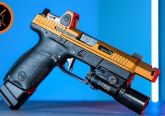Review: Walther PDP Handgun in 9 mm
Walther Arms has been putting out some very good pistols for a very long time. Nonetheless, despite consistently producing the best trigger among mass-produced, striker-fired guns, Walther pistols seemed to get lost in the crowd. One company leapt to the forefront of the polymer-frame, striker-fired pack and has refused to give up its lead. Another won the U.S. military pistol contract. Yet, another maintains a cult-like following despite (actually, because of) abusing its fans. And there are many others occupying various niches within the personal-protection pistol market.
Well, a rising tide lifts all boats. The market’s currently rising tide is, of course, due to the uncertainty of social upheaval, a pandemic, movements to defund police departments and anticipated assaults on gun rights. And onto this tide Walther has launched its new flagship—the PDP.

- Buy All-American!
- Bring health and vitality back to your body with these non-transdermal patches
- Get your Vitamin B17 & Get 10% Off With Promo Code TIM
- How To Protect Yourself From 5G, EMF & RF Radiation - Use promo code TIM to save $$$
- The Very Best All-American Made Supplements On The Market
- Grab This Bucket Of Heirloom Seeds & Save with Promo Code TIM
- Here’s A Way You Can Stockpile Food For The Future
- Stockpile Your Ammo & Save $15 On Your First Order
- Preparing Also Means Detoxifying – Here’s One Simple Way To Detoxify
- The Very Best Chlorine Dioxide
- All-American, US Prime, High Choice Grass-Fed Beef with NO mRNA, hormones or antibiotics... ever!
A Different Gun
It’s ironic that Walther’s most iconic (not most historically significant; that would be the P38) pistol is the PPK, because in many ways the new gun is the polar opposite of 007’s preferred weapon. The PPK is a small, sleek, heavy, all-steel, modestly powered and low-capacity pistol with what can be kindly described as a heavy double-action trigger. Blessedly, the PDP is none of those things (which is not to denigrate the PPK, a pistol that will eternally earn cool points.)

Even in Compact guise (which we’re focused on here), the PDP is not little. It’s pleasantly, reassuringly, hand-fillingly ergonomic. It’s not excessively large, it’s just that you are not going to fumble for it when drawing from concealment. It’s not sleek. That may sound like a bad thing and, aesthetically, maybe it is. But, sleek often equates to slippery. The blocky blaster that is the PDP is remarkably easy to manipulate with no false moves.
With its polymer frame, it weighs slightly more than 24 ounces empty, just a few ounces more than the Lilliputian PPK. Its 9 mm chambering is now the standard for our military and most law-enforcement agencies. The double-stack magazines of the Compact hold 15 rounds of 9 mm (18 rounds in the full-size model) as opposed to the PPK’s six or seven rounds of .380 ACP. As for the trigger, well, Walther retains and maybe even extends its advantage over its striker-fired competitors. Compared to the PPK’s double-action pull, the PDP trigger takes only about one-third the effort.

Far Sighted
The PDP comes with a fully adjustable rear sight. Granted, part of the reason for this is to earn importation points, as a pistol with adjustable sights is deemed to have a sporting purpose, while fixed-sighted pistols are not. Even so, the unit included with the PDP is pretty decent. It has a big, square notch that allows plenty of light on either side of the front post for aiming that’s both fast and precise. Moreover, the sight is protected by sharp-angled wings that keep it both protected and snag-free.
Further, the wings are square enough to enable one-handed racking of the slide on a hard surface in the event of an emergency. The three-dot setup is not illuminated, but Walther has arguably arrived at something better: Choice. The company recognized that sights are highly personal for many folks and often the first component swapped out. To that end, Walther acknowledged the popularity of a certain Austrian pistol and made its rear-sight dovetail the same as its competitor’s. Want to replace the Walther sight for some reason? You now have the option of anything on the considerable aftermarket for that “other” pistol.

Cocking serrations now come in many forms. Some are very fine, others are cut like fish or snake scales or otherwise stylized. Walther describes the PDP’s large, forward-canted serrations as being “SuperTerrain” because they project out beyond the original dimensions of the slide rather than being cut into it. They are really big, but I can’t argue with their effectiveness. They grab you as much as you grab them (though they didn’t snag on cover garments). They aren’t exactly graceful, but I’ll take useful over elegant any day.
There is a surprising amount of R&D incorporated into the grip frame. The slight recess at the juncture of the grip frame and the trigger guard that permits a high hold to maximize control is held over from earlier designs. The surface of the grip frame (except for the checkered frontstrap) has what the company calls “performance duty texture.” Polymer frames are notoriously slippery. The answer has typically been custom stippling or Talon Grips adhesive appliques.
However, some manufactures are now offering adequate stippling from the factory. This “performance duty texture,” though, is the best thing I’ve seen from a factory; very tactile without being abrasive. Additionally, Walther integrates a slight palm swell and three flat, subtle ridges that form barely perceptible finger grooves. As is the trend for premium polymer-frame pistols, the PDP comes with multiple (three) interchangeable backstrap inserts so the end user can customize the fit.
The final notable bit about the grip frame relates to another aspect of the PDP: The pistol is beyond “red-dot-ready.”

More Than Just a Slide Cut
As MRDS master Scott Jedlinski has noted, right-handed shooters who are adjusting to an MRDS-equipped pistol and having trouble locating the dot typically aim high and left. However, if they exert pressure with the pinky finger of their strong hand, the dot will suddenly appear in the window. With this in mind, the bottom of the PDP’s frontstrap protrudes to give leverage for the application of pressure from the pinky.
But Walther didn’t stop there in prepping the pistol for red-dot use. Of course, the PDP has a pre-cut slide, but one that’s especially deeply cut. In fact, an Aimpoint Acro sits so low on the PDP slide that it will co-witness with the front post. Tell Walther what red-dot sight you intend to mount, and the company will include the correct mounting plate as well as a cover plate should you choose to stick with irons.

Maximum Modularity
Modularity is a big talking point when discussing recent pistol designs. Walther jumps right in here, too. The 5-inch PDP full size will have 4- and 4.5-inch slides available from the company, while the 4-inch Compact will fit a 5-inch slide, too, should you desire something a little different. Want a CCO configuration? Mate a full-size barrel and slide to the Compact’s frame. Want a full-size, maximum-capacity pistol that’s short and fast-handling? Put a 4-inch upper on the full-size frame.
The niceties don’t end there. There’s an extended slide release—the actuation of which doesn’t require you to change your grip—and a large but protected magazine-release button. There is also a stepped chamber incorporated. This proven system, featuring a millimeter’s width of tightened fit at the front of the chamber, keeps pressure consistent, maximizing velocity while minimizing fouling. The looser fit towards the rear of the chamber assures reliable extraction.
When I think of Walther, I think trigger pull. OK, first I think “James Bond,” but trigger pull is a close second. I fired a Walther PPQ 45 that has the best out-of-the-box, striker-fired trigger I’ve felt. It now has a rival. Broken down, the pull seems complex and unimpressive. You collapse the bladed safety until it is flush with the front of the trigger. You then move both through about a quarter-inch of slack. Then there is engagement and a gentle roll like a car passing over an old and well-worn speed bump, then a low wall before the trigger breaks. While it sounds awful deconstructed, when you fire the pistol normally, you don’t feel all of that. You feel smooth, manageable resistance too slight to move the sights off target before the shot breaks—exactly what you want.
 Shooting Impressions
Shooting Impressions
The pistol shot nicely. Felt recoil was moderate and the sizable slide seemed to quell muzzle rise. The controls actuated easily and positively. A colleague who shot it lauded the effective, yet non-abrasive grip texture. She also liked the shape and width of the trigger, but expressed concern about the mushy and indistinct reset.
There were no failures to feed, fire or eject experienced throughout the testing of the pistol.
Thoughts
I own a pistol this good. It’s as comfortable, accurate and reliable as the PDP. Its grip frame has purchase equal to Walther’s new gun. And it has a compact frame and full-size slide. The problem is, my gun is the result of a “build.” I ordered, filed and fitted a trigger connector. I replaced the sights.
A gunsmith did a double undercut of the trigger guard. I added Talon Grips. The slide isn’t cut for an MRDS, though that was an option when I was putting it together. The CCO configuration required an aftermarket barrel and a frame extension.
All told, Walther’s greatest achievement with the PDP may be this: It is (for me) the most complete out-of-the-box, striker-fired pistol available at anywhere near the price. Despite the gun described above, I am not a tinkerer by nature, just picky. This would be one pistol I could live with in stock configuration, yet—remarkably—it may also be the simplest to modify, should you so desire.


Don't forget to like us on Facebook and follow us on Twitter.














